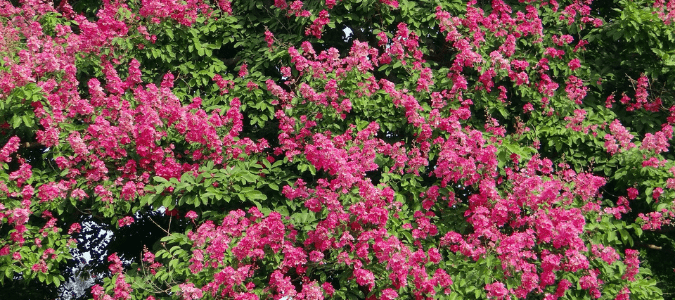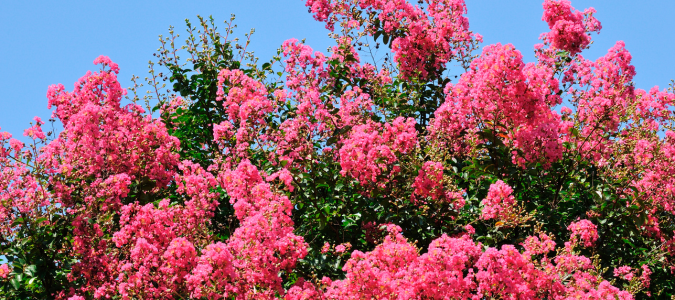Crape myrtle is a gorgeous plant that boosts the curb appeal of any home. They produce a cloud of beautiful and colorful blooms in the summertime and rich-colored green leaves in the fall.
If your crape myrtle is not blooming, there could be many reasons, such as too much shade, insufficient water, improper pruning or a soil imbalance. Keep reading to learn how to correct these problems so that your crape myrtle will bloom its beautiful flowers again.
Next, the growth of black fungus can weaken crape myrtle plants and detract from their beauty. Seeing sooty mold means that your crape myrtle has an insect infestation you must deal with before it spreads further.
Lastly, crape myrtle aphids are the most common pest to infest crape myrtle trees and shrubs. They suck the sap from the leaves and leave a sugary substance that causes black mold to grow. Luckily, there are easy ways to prevent and reduce the number of these pests.
The best way to properly care for your crape myrtle, especially when it is not blooming or unwell, is to contact a professional.
Why Is My Crape Myrtle Not Blooming?
Crape myrtle plants are popular in the southern states for several reasons. First, they come in various sizes and heights, from short bushes to towering trees. Crape myrtles typically bloom in the summer, producing beautiful flowers in various colors, including white, pink, purple and red.
These trees also produce beautiful fall foliage; the two-tone bark is even nice to look at in the winter after their leaves have dropped. Crape myrtle trees add tons of curb appeal to homes; however, it is always disappointing when they do not bloom.
There are a few reasons why your crape myrtle is not blooming and producing beautiful flowers. First, your bush or tree may get too much shade to bloom. Crape myrtle plants need six to eight hours of continuous sunshine to bloom properly.
Make sure you plant yours in a sunny spot where it is not blocked by other trees. Sometimes, cutting back the surrounding trees will give your crape myrtle more daily sunlight.
Next, improper pruning, or pruning too late, can cause crape myrtles not to bloom. Your tree or bush needs plenty of time to produce new growth in the spring. Pruning it after it has started growing will inhibit that necessary new growth. Crape myrtles come out of dormancy in March, so you should prune in January or early February. Additionally, crape myrtles don’t always need to be pruned. An expert who knows how to prune crape myrtles can help you decide when to prune your plant.
Not pruning away dead branches can also cause crape myrtle to stop growing. The new branches don’t get enough air or sunlight if your tree is crowded.
Another reason crape myrtles may not bloom in the spring is drought. While they are resilient plants, crape myrtle trees and bushes still need enough water to grow. They like to be soaked at the root. You can do this with a hose or leave a sprinkler on for around an hour.
Lastly, a soil imbalance may be another hurdle to crape myrtle growth. If your soil is too fertilized, there may be too much nitrogen or not enough phosphorous. A lawn care specialist can properly fertilize your yard, giving your plants the nutrients they need.
Do not give up on your beautiful crape myrtle blooms. Sometimes they bloom late after summer rainfall. Whatever the problem is, an expert can help you get to the bottom of it and provide your crape myrtle with the right conditions to bloom every year.
What Does Black Fungus on Crape Myrtle Mean?
Another problem that can interfere with crape myrtle growth is a black fungus, also referred to as sooty mold. This disease leaves a black residue on your crape myrtle leaves and stems that makes your plant appear dirty.
Sooty mold on your crape myrtle plant indicates an insect problem. Multiple types of pests, including mealybugs, aphids, whiteflies and scales, can cause sooty mold by sucking the sap from the crape myrtle. This causes honeydew to grow on the plant, leading to fungal growth.
The good news is that sooty mold does not kill your crape myrtle tree or bush. But, it is unsightly and deters from your plant’s beauty. Advanced sooty mold growth can also weaken your crape myrtle.
There are several options when it comes to deterring these crape myrtle pests. First, you can use insecticidal soap on your crape myrtle plant every four to seven days in the spring and summer. You can also spray your leaves with horticulture oil every two weeks after the sun has gone down. Lastly, you can use a single-application systemic insecticide on the soil to control insect activity.
While prevention is key to avoiding sooty mold, several treatment options are available once it has developed on your plant. Remember to inspect your plant regularly to catch sooty mold growth early when it is easier to deal with. The more it spreads, the harder it is to remove.
You can remove sooty mold by rinsing your leaves with soap and water. Create the solution by mixing four ounces of dish soap with a gallon of water. Next, use a spray bottle to spritz your leaves. Wait five minutes before rinsing the solution off with a hose. If any sooty mold remains, scrub it off your leaves with a soft brush.
The great thing about crape myrtle trees is that they have self-exfoliating bark. That means the tree sheds its bark in thin sheets to make way for new growth. If sooty mold has made its way to your bark, it will eventually shed off. Also, leaves with stubborn sooty mold growth that you cannot remove will eventually drop in winter.
While black fungus, or sooty mold, is not a huge threat to your crape myrtle, it can weaken your plant’s growth and detract from its beauty.
What Are Crape Myrtle Aphids?
Crape myrtle aphids are one of the most common pests to affect every type of crape myrtle trees and shrubs. They are a particular class of aphids that only infest crape myrtle trees and shrubs. They are incredibly small insects that only measure one-sixteenth of an inch long.
Adult crape myrtle aphids have pale bodies that are a yellow-green color. They also have a single black spot on their abdomens, black wings, dark antennae and two humps on their backs. Crape myrtle aphid nymphs look similar to adults but are smaller and do not have wings.
These pests suck on falling sap from crape myrtle plants, which produces a sugary and sticky substance called honeydew on the surface of the leaves. Honeydew leads to sooty mold growth, weakening your crape myrtle plant.
Crape myrtle aphids overwinter as eggs and hatch in the spring, so staying on top of pest control in the new year is important. Starting in May, you should also regularly inspect your crape myrtle for aphid activity.
These pests sit on the underside of the leaf, so you can see them when you look up at the tree from the ground. You may need to use a magnifying glass to identify them. Since they are tiny pests, you may be able to wash them away with a blitz of water. However, an advanced population will require other treatment methods.
Crape myrtle aphids reproduce rapidly and can cause mold damage to your plant extremely quickly. Treatment options include insecticides and spraying a horticulture solution on your leaves.
Prepare Your Crape Myrtle for Summer Blooms Now
Summertime is approaching quickly, so it’s time to prepare your crape myrtle for beautiful blooms. Ensure the plant gets plenty of sunlight and is properly pruned before new growth begins.
To prevent sooty mold growth, you should also protect your crape myrtle from bug infestations. Preventing crape myrtle aphids from infesting your plant is the best way to keep it healthy and beautiful.
Call a professional yard care service for the best crape myrtle care.
ABC Can Keep Your Crape Myrtles Healthy
There can be a lot involved with taking care of trees. For healthy, happy trees, contact ABC Home & Commercial Services. Our certified arborists will ensure that your trees are on a care plan that helps them grow strong and beautiful.



